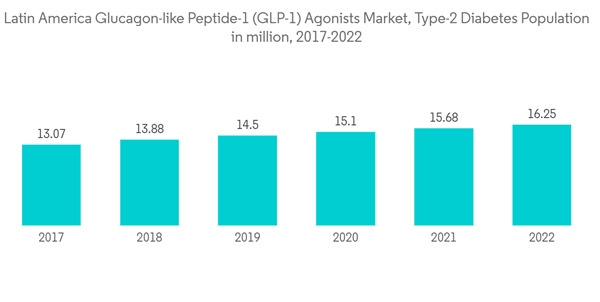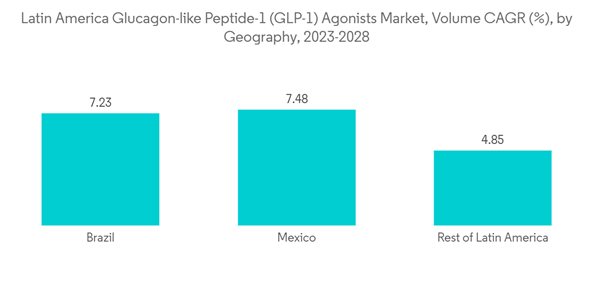The market is estimated to reach a value of about USD 211 million by 2027.
The COVID-19 pandemic positively impacted the Latin America Glucagon-like Peptide-1 (GLP-1) Agonists Market. Diabetes and uncontrolled hyperglycemia are risk factors for poor outcomes in patients with COVID-19 including an increased risk of severe illness or death. People with diabetes have a weaker immune system, the COVID-19 complication aggravates the condition, and the immune system gets weaker very fast. People with diabetes have more chances to get into serious complications rather than normal people. The COVID-19 pandemic has been testing the capacity to respond and adapt to populations, governments, and health systems worldwide. Brazil presented the first suspected and the first confirmed case in the Latin America region. Most Latin American countries failed to implement timely measures to protect individuals with diabetes, which severely impacted individuals, health systems, and economies.
Glucagon-like peptide-1 receptor agonists (GLP-1RAs) are a class of medications used for the treatment of type 2 diabetes and some drugs are also approved for obesity. One of the benefits of this class of drugs over older insulin secretagogues, such as sulfonylureas or meglitinides, is that they have a lower risk of causing hypoglycemia. Besides being important glucose-lowering agents, GLP-1RAs have significant anti-inflammatory and pulmonary protective effects and an advantageous impact on gut microbes' composition. Therefore, GLP-1RAs have been potential candidates for treating patients affected by COVID-19 infection, with or even without type 2 diabetes, as well as excellent antidiabetic (glucose-lowering) agents during COVID-19 pandemic times.
The diabetic prevalence is high in countries in the Latin American region, and Mexico is known to have a high number of diabetic patients due to the growing prevalence of Type-2 diabetes in the country. The gradually growing obesity rate, combined with the genetic predisposition for Type-2 diabetes, acted as a prominent driver for the increase in the Type-2 diabetic population over the last 40 years. Currently, nearly 10% of the population is living with diabetes. Diabetic patients in the Latin American region mainly suffer from Type-2 diabetes, accounting for nearly 90% of the total diabetic population in 2021.
Therefore, owing to the aforementioned factors the studied market is anticipated to witness growth over the analysis period.
Latin America Glucagon-like Peptide-1 (GLP-1) Agonists Market Trends
The Dulaglutide Segment holds the highest market share in the Latin America Glucagon-like Peptide-1 (GLP-1) Agonists Market in the current year
The dulaglutide segment holds the highest market share in the Latin America Glucagon-like Peptide-1 (GLP-1) Agonists Market in the current year and is expected to register a CAGR of more than 9% over the forecast period.GLP1RAs have been available internationally and are recommended for use when escalation of treatment for type 2 diabetes is required after metformin and lifestyle management. They can be safely used with all other glucose-lowering therapies except vildagliptin. Dulaglutide (Trulicity) is a weekly subcutaneous GLP 1 RA that is highly effective for reducing HbA1c with additional weight loss and cardiorenal protection benefits. Therapy with dulaglutide allows many patients to reach and maintain target HbA1c without insulin and/or sulfonylureas, eliminating the associated hypoglycemia risk. GLP1RAs elicit greater weight reduction and are recommended over SGLT2 inhibitors when cerebrovascular disease other than heart failure or renal disease predominates.
According to the IDF Diabetes Atlas 2021, 15.7 million adults, or 10.5%, were living with diabetes in Brazil. The cost of diabetes-related health expenditures in Brazil is the third-highest in the world. In addition, 18 million adults have impaired glucose tolerance, which places them at high risk of developing type-2 diabetes. Additional data on glycemic control in Brazil show that only 25% met the therapeutic goal of glycated hemoglobin (HbA1c) less than 7% before the pandemic, as recommended by the Brazilian Diabetes Society.
When diabetes is undetected or inadequately treated, people with diabetes are at risk of serious and life-threatening complications, such as heart attack, stroke, kidney failure, blindness, and lower-limb amputation. These result in reduced quality of life and higher healthcare costs, which lead to a greater need for access to care. Brazil has implemented a set of reforms over the past decade to improve the distribution of doctors, develop new forms of service organization, introduce new financing models, and implement a range of quality improvement initiatives and policy frameworks to overcome risk factors such as obesity and emerging pandemic threats.
Owing to the rising rate of obesity, the growing genetic factors for type-2 diabetes, and the increasing prevalence, it is likely that the market will continue to grow.
Mexico is expected to register the highest CAGR in the Latin America Glucagon-like Peptide-1 (GLP-1) Agonists Market over the forecast period
Mexico is expected to register the highest CAGR of more than 6.5% in the Latin America Glucagon-like Peptide-1 (GLP-1) Agonists Market in the forecast period.According to the IDF Diabetes Atlas 2021, the prevalence of diabetes in Mexico reached 16.9%, or one in six adults. Additionally, 11 million adults in the country have impaired glucose tolerance, which places them at high risk of developing type-2 diabetes. Diabetes-related health expenditure in Mexico has put it in the top ten countries or territories with the highest total health expenditure. Under half of the people living with diabetes in the country are undiagnosed.
GLP-1 RAs can be taken alone or in combination with other treatments for type-2 diabetes to improve blood glucose management, i.e., time in range. In addition to lowering blood glucose, they benefit heart health by reducing the risk of heart attack, stroke, and heart-related death. This is important because people with type 2 diabetes are at substantially higher risk of heart disease than those without diabetes.
Lack of health insurance deprives the poor of access to services and puts them at risk of financial hardship. To protect the people against excessive health expenditures, many countries like Mexico have implemented mechanisms such as community-based health insurance, national health insurance, and targeted public health insurance. Mexico has multiple health insurance providers. The Instituto de Seguridad y Servicios Sociales de los Trabajadores del Estado (State Employee's Social Security and Social Services Institute, ISSSTE) provides coverage for government employees, and the Instituto Mexicano del Seguro Social (Mexican Social Security Institute, IMSS) covers private-sector employees. The Seguro Popular (People's Insurance) was launched to protect the working-age population against steep healthcare costs. Enrolment in the Seguro Popular is independent of health status or pre-existing illness; there is no co-payment in accordance with the type of health care received; and family contributions are determined solely by the ability to pay. The Government of Mexico partnered with numerous private companies to utilize their supply chain (manufacturing, distribution, and retailers) to ensure low prices for drugs. The various initiatives by the Mexican government are expected to drive the market's growth.
Latin America Glucagon-like Peptide-1 (GLP-1) Agonists Industry Overview
The Latin America glucagon-like peptide-1 (GLP-1) agonists market is consolidated, with a few major manufacturers like Eli Lilly, AstraZeneca, Merck, Boehringer Ingelheim, and Novartis, etc. gaining presence in major countries while the remaining market comprises other local or region-specific manufacturers.Additional Benefits:
- The market estimate (ME) sheet in Excel format
- 3 months of analyst support
This product will be delivered within 2 business days.
Table of Contents
Companies Mentioned (Partial List)
A selection of companies mentioned in this report includes, but is not limited to:
- Novo Nordisk
- AstraZeneca
- Eli Lilly and Company
- Sanofi
- Novartis
- Biocon
Methodology

LOADING...










